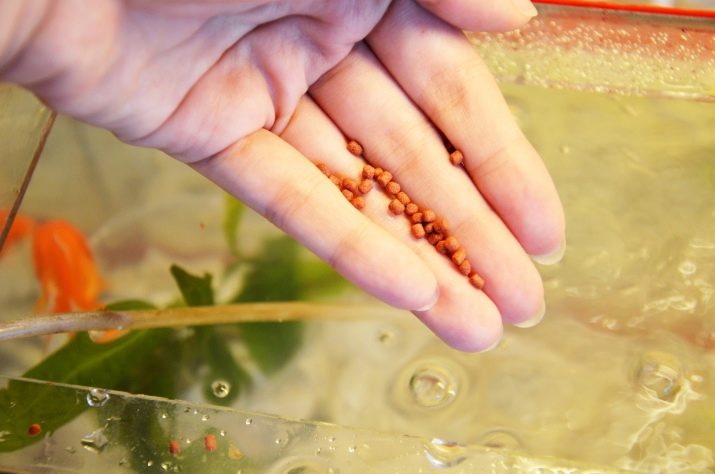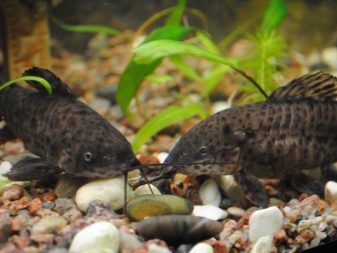Somik tarakatum is an aquarium fish that is distinguished by its cheerful and cheerful disposition. The behavior of these inhabitants of artificial reservoirs completely does not correspond to our ideas about the nature of bottom fish. These pets do not spend all their time at the bottom, do not dig into the ground and do not hide behind snags. On the contrary, they really like to swim in the upper layers of the water column and pick up food from the surface.
Description
In appearance, catfish taracatum are rather inconspicuous, but their unusual behavior attracts their eyes and sets them apart from brightly colored fish. Taracatums are distinguished by their activity and mobility, they literally radiate cheerfulness and this often gives the feeling that the fish are always in a good mood.

Tarakatum belong to the family of armored catfish, in the natural environment they live in small fast rivers of South America, but often they can also be found in bodies of water with stagnant water, including on the islands.
Since this species of fish has a wide habitat, there are a lot of ecotypes, nevertheless, all representatives of tarakatums have common features.

The body is elongated and slightly flattened, most noticeable in the abdomen. Bone plates are located on the sides, the head is powerful, the muzzle is pointed. Near the mouth there are two pairs of whiskers: one pair from the bottom - the catfish use it to probe the bottom, and the second is directed up and slightly to the sides - they are necessary for the catfish to feel the direction of the flow and the obstacles on the way.

The color depends on the subspecies. - cockroaches can be painted in different shades from light beige to dark brown. Small spots are noticeable on the head, torso and in the fin area, they usually appear in the teenage period and remain until the end of life. Abdomen is painted in beige or light cream color. Rarely, albino taracatums are found.


The length of catfish on average is 10-14 cm, but sometimes especially large individuals come across - their size reaches 18 cm. Tarakatums live in nature for 5-6 years, but when creating a favorable habitat in the aquarium, their life expectancy can reach 10 years.

Gender differences
Distinguish a female from a male pretty easy:
- females are much larger than males;
- in females the fins are rounded, and in males they have a shape resembling a triangle;
- the pectoral fin ray in males is rather sharp and slightly thickened, at the moment of sexual activity it becomes yellowish-orange;
- during spawning, the abdomen of a male changes its light shade to violet-blue;
- the female does not change color during the spawning period, although the abdomen becomes more complete.

Maintenance and care
The maintenance and care of cockroaches does not present any difficulty for aquarists, the most important condition is to acquire several individuals at once. These catfish are schooling fish, in nature they exist in groups of 500-1000 units, so when kept alone they will experience severe stress.
Cockroaches love space, they need a large aquarium, the bottom area should be large. In addition, you should purchase all kinds of shelters for catfish: shards, turrets, houses or grottoes.
Every week, water must be replaced by a third of the total. If the liquid is very dirty - you can replace half the water.


Cockroaches in nature live in a hot climate, therefore, the microenvironment in an artificial reservoir should be appropriate. Suitable conditions for keeping fish:
- water temperature - 25-27 degrees;
- acidity — pH 5.7-7.5;
- rigidity - 20-25 units.
Plants must be planted in the catfish aquarium - they scatter the light and create the blackout necessary for the cockroaches. It is best to use duckweed and riccia, which will partially cover the surface of the reservoir.
However, do not forget to ensure that pets have access to the surface of the water.


When choosing a substrate, it is better to give preference to smooth and necessarily coarse soil, although sand is also suitable. Small river pebbles should not be used, since catfish will certainly raise turbidity and thereby pollute the reservoir.
It is very important to organize high-quality filtration in the aquarium. In the natural environment, these fish live in rivers with a noticeable course, therefore, the filter must be powerful so as not only to purify the water, but also to create streams of water.
Despite the fact that cockroaches can breathe air, nevertheless, aeration is important for catfish, so a compressor must be placed in the aquarium.


Fish do not like bright light, so you should not put the tank near a window or near another light source. Aquarium lamps are also not needed - these fish are suitable for twilight and faded light, in addition, darkened shelters must certainly be present in the tank.

Feeding
Tarakatums, like any other large fish, need a large amount of food and a very diverse diet. For catfish, both live and dry food are suitable.
Dry food in the form of cereals, tablets or granules - it can be bought at any store, the product is enriched with all the vitamins and supplements necessary for fish. Typically, graduated feeds include several rulers - for fry, for adults, for sick pets. Also, manufacturers produce products to improve coloring and other varieties of feed.
Of the live foods, tarakatums really like bloodworms, artemia, chopped worms, as well as minced seafood, such as shrimp.

Herbal components must be included in the diet - lettuce and dandelion greens. Soms need to be fed a couple of times a day, preferably in the dark, then your pet will always be alert, cheerful and full.

Compatibility
Somics of tarakatum are mostly nocturnal. In daylight, they are passive and almost inactive. This fish does not show much interest in the remaining inhabitants of the artificial reservoir, unless they invade the bottom territory. Thanks to such qualities, catfish can get along with any neighbors, except for those who are too active and aggressive. Best of all, cockroaches get along with the following species:
- zebrafish
- tetra;
- parsing;
- goldfish;
- scalars.



When choosing neighbors, it is advisable to be guided by the following criteria:
- body length more than 6-7 cm, otherwise the catfish will begin to chase the fish and can even eat them;
- fish should swim mainly at an average level in the water column;
- discard bottom fish - the abundance of pets at the bottom will cause taracatum stress due to lack of space;
- Do not breed catfish with territorial fish such as bots and cichlids.

Breeding
To breed cockroaches is quite simple. Taracatum reaches puberty by 8-15 months, reproduction of these catfish at home does not present any difficulties - the fish form pairs on their own.


In order to stimulate spawning, it is necessary to lower the water temperature by 4-5 degrees, and during this period, intensively feed future parents with food of animal origin. There should be so much food that catfish stumble upon it at the slightest movement.
If possible, put an inverted saucer at the bottom - the male will arrange a nest there, after which the female will begin to spawn (up to 1000 eggs). Incubation lasts 4-5 days, hatched young animals are fed artemia, daphnia or live dust. When the fry begin to swim on their own, they can be transferred to a common aquarium.
How to maintain and breed catfish of cockroaches, see the video below.










